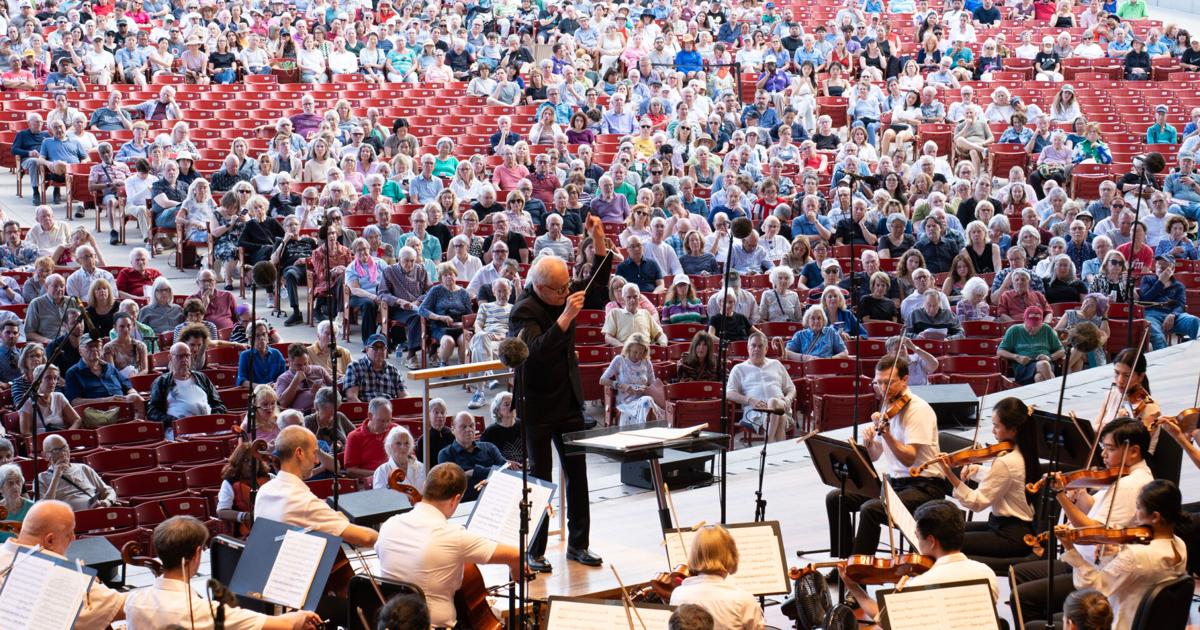The Grant Park Music Festival is one of the nation’s few free outdoor classical music series. It was created in 1935, when Chicago Mayor Anton Cermak and James C. Petrillo, the president of the musicians’ union, got together with an idea of putting classical music in a park. Today, the GPMF offers nearly 200 free concerts and events across the city every summer.
Last week, the GPMF offered a splendid concert at the Pritzker Pavilion in Millennium Park made up of a new classical work plus two very popular classics, all led by guest conductor Osmo Vänskä, a Finnish conductor who is best known in the U.S. for his work with the Minnesota Orchestra from 2003 to 2022.
The concert opened with brief remarks by composer Henry Dorn (b. 1988), whose “Transitions” was first on the program. Dorn explained that the work was about the death of his mother from cancer. Cancer, according to the composer, “comes like a thief in the night and enters like a pest, and then it proliferates.” His music captures the horror of cancer, the sounds of a hospital and a lyrical melody representing his mother’s thoughts after she had lost the ability to speak.
Vänskä knows “Transitions” well. He conducted the world premiere in 2022 with the Minnesota Orchestra and has subsequently performed it with the Detroit and Atlanta Symphony Orchestras. His outing with the Grant Park Orchestra was engaging. He drew out spikey sound, creating confusion that was insistent. There were clickety-clack elements that mimicked both hospital machines as well as the well-oiled movements of staff going through their daily routines and the bureaucratic drone of a complex institution. The befuddlement was relentless while the English horn solo, representing the mother, was a fragrant moment of release and calm. It was interesting music that made a strong point.
Next up, violinist Paul Huang joined Vänskä and the orchestra for one of Max Bruch’s most beloved works, the “Scottish Fantasy.” It is based in part on folk songs from Scotland, including “Auld Rob Morris,” “Thro’ the Wood, Laddie,” “I’m a’ Doun for Lack o’ Johnnie,” and “Scots Wha Hae.” These lovely melodies and the integument Bruch used to connect them all together were completely understood by Huang, who performed with breathtaking beauty and insight.
The work opened with grave sound from the orchestra, plaintive and at times sorrowful. But it didn’t take long for the “Adagio cantabile” to take over, and Huang’s sweet sound was persuasive and his ability to infuse the folk music throughout the work with vigor was compelling. The dynamic contrasts were striking and the violinist’s understated playing had strong effect. The “Scherzo” had muscle and Huang dispatched rapid lines with ease, never sacrificing clarity. He had ringing high notes and the violin interplay with the flute was beautifully done by both musicians.
Huang caressed the music in the next movement, with the gorgeous melodies given room to breathe and expand. His playing amounted to storytelling of the highest order. For the finale, Vänskä ensured that the orchestra was forceful and direct, while Huang raced through the exciting passages with style as well as a bit of flash. There was birdsong delicacy as well as emphatic soaring, bringing the music to a satisfying conclusion. This was followed by a brief but marvelous encore: The “Scherzo–Caprice” by Fritz Kreisler.
After the intermission came the biggest work on the program, Beethoven’s Symphony No. 6. The composer’s full title makes clear his musical intentions: “Pastoral Symphony, or Recollections of Country Life.” It is the composer’s only symphony in five movements and these do not have typical markings, but instead are clearly descriptive.
“Awakening of cheerful feelings on arrival in the countryside” is how the first movement is described and Vänskä indeed imbued the music with a rustic quality, which was also smooth and pleasing. The music was more than cheerful, with robust and energetic playing and a beguiling warmth.
The “Scene by the brook” featured splendid work by the winds that imitate bird calls: the flute sings as the nightingale, the oboe as the quail and two clarinets represent the cuckoo. The strings created a subtle sense of flowing water.
The middle movement, “Merry gathering of country folk,” represents country dances and revels and Vänskä drew out the smiles and the fellowship and gave the dance music an irresistible sense of gleeful swirling. The music gathered speed by the end and collided directly into the next movement, “Thunder, storm.” The low strings used tremolos to mimic thunder in the distance, with timpani creating the closer claps of sound. The piccolo created lightning and the violins offered both winds and rain. This was done with good balance, Vänskä like a sorcerer following a particular storm recipe. An ascending flute passage representing a rainbow was particularly pretty.
The final movement is “Shepherd’s song. Cheerful and thankful feelings after the storm.” Vänskä ensured that the music was full of earnest feeling, both simple and beautiful. The final section had a gradual buildup and a prayer-like power. The music came to a close with fervent thankfulness. It was a memorable performance.
Beethoven’s Pastoral Symphony is such a life-affirming, joyful work that it makes a specific contrast to Dorn’s opening musical essay on cancer. There are so many reasons the death of a loved one pains us, but one of the reasons is that they will never again experience with us the simple joys Beethoven celebrates in his sixth symphony. Dorn helped me to value that all the more with his thoughtful composition.

